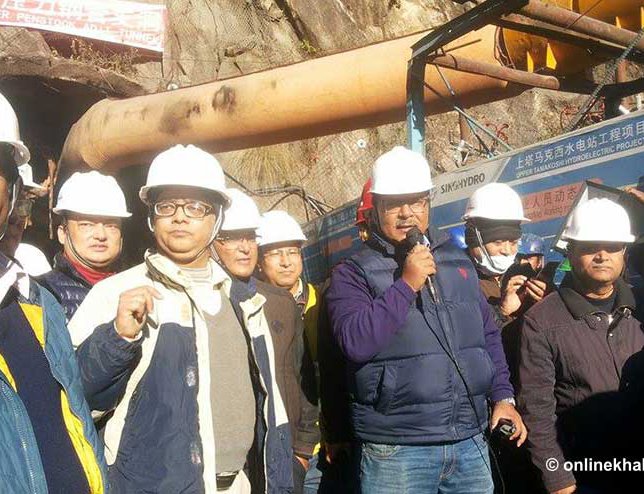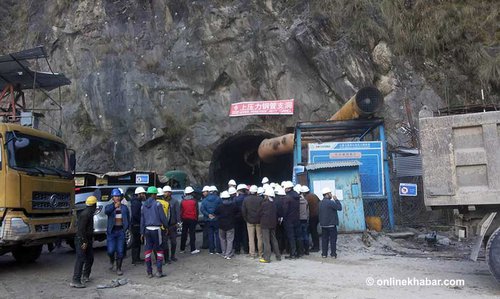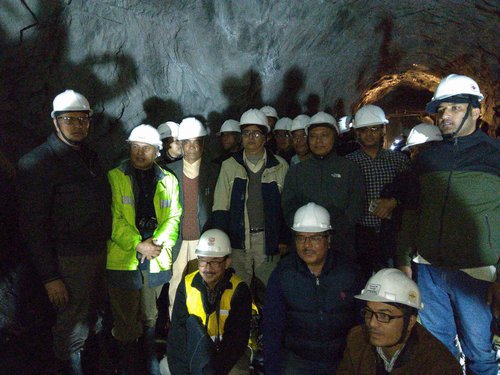
Although Upper Tamakosi Hydropower Project faced several hurdles at the last stage of its construction, from causes ranging from earthquake and blockade to road obstruction, CEO of Upper Tamakosi Hydropower Ltd Shrestha never lost hope.
With hi quiet demeanor, Shrestha led a team that finally made a major achievement, building the headrace tunnel and completing ninety percent of the civil work despite all the hurdles.
“Feeling relaxed with the Upper Tamakoshi Hydroelectric Project at Upper Tamakoshi. Succeeded to make the tunnel breakthrough. We are thankful to all. It’s celebration time,” Shrestha wrote on his Facebook wall on November 19, 2017.
The earthquakes of 2015 had badly damaged the project. The road to headwork was completely washed out by floods. Similarly, project office building had collapsed. Initially, there was doubt about the very future of the project.
The length of the tunnel of UTHEP is 8.5 km, which is the longest among all hydropower projects that have been constructed here so far.
The 456-megawatt UTHEP is the largest capacity hydropower project in the country being constructed through the country’s own resources.
The project is being financed by Nepal Electricity Authority, which has 41 percent stake in Upper Tamakoshi Hydropower Ltd. Other shareholders include Nepal Telecom (six percent), Citizen Investment Trust (two percent), Rastriya Beema Sansthan (two percent), public (15 percent), locals of Dolakha (10 percent), depositors of Employees Provident Fund and employees of NT, RBS, CIT and EPF (24 percent).
Initial estimates had put the total cost of constructing the project at Rs 35 billion, but Rs 38.83 billion has already been spent on it. By the time the project is completed, its total cost is expected to hover around Rs 42 billion, added Neupane.
The project started again from the ashes in a virtually hopeless situation. Along with building infrastructure, CEO Shrestha injected the hope in the project staff, particularly the technical manpower that there was no danger any longer.
In this scenario, the jubilant statement of Shrestha is understandable as the team of Upper Tamakosi was in a heavy pressure whether they will complete the project on time or not. After this, the construction of 8.5 kilometers of the tunnel came to an end. This is the major project Nepal is constructing using its own resources and Nepal’s own technical manpower.
This project will give a new mileage for Nepali engineers as well. Upper Tamakosi will add a feather in their hat to show that they could complete such a big project.
MD Kul Man Ghising and Secretary Anup Kumar Upadhyaya were two important personalities standing for the project and backing it all the time. At the time of the breakthrough, the presence of secretary Upadhyaya and MD Ghising showed their backing to the project leadership.
The headrace tunnel of the Upper Tamakoshi Hydroelectric Project, a National Pride Project, was completed after almost five years since the construction started in August 2012. Headrace tunnel construction is a major segment of a hydropower project, as it connects the reservoir to the power station.
Energy Secretary Anup Kumar Upadhyay was present on the occasion to encourage the project team to complete the project within the stipulated timeframe.
Along with the tunnel breakthrough, 92 percent of the project has been completed and UTHEP is expected to start commissioning power after 10 months, according to Bigyan Shrestha, project chief of UTHEP.
“The completion of headrace tunnel is a major achievement for any hydroelectric project and we’ll be able to commission power after 10 months,” he said.
The civil contract of the project is with Chinese contractor, Sino Hydro.
When the project was initiated in 2011, it was supposed to have been completed by mid-July 2016.
However, the deadline was postponed to mid-July 2018, as the construction of the project was delayed by a few months in the initial stage and later the project work was stalled for one-and-a-half years after the devastating earthquake of April 2015. Dolakha, where the project is located, was badly affected by the quake.
Though the earthquake had not damaged the tunnel, the damage caused to the access road significantly delayed the project work. The devastating earthquake followed by trade disruptions in the southern plains of the country stalled the project work for almost two years, according to Ganesh Neupane, spokesperson for the project.
(Photos and video Courtesy: Sachen Gautam)

Keshab Poudel
Poudel is the editor of New Spotlight Magazine.
- CLA: Samriddhi For Skill Development
- Apr 23, 2024
- ECONOMY: Growth At 3.3
- Apr 16, 2024
- DPM’s SHRESTHA’S CHINA VISIT High Profile, Low Key
- Apr 14, 2024
- Maha Kumbha In Barahkshetra: A Sacred Festival In Sacred Koshi (Kaushiki) River
- Apr 09, 2024
- LOSS AND DAMAGE: Upper Tamakoshi A Case
- Apr 02, 2024
















